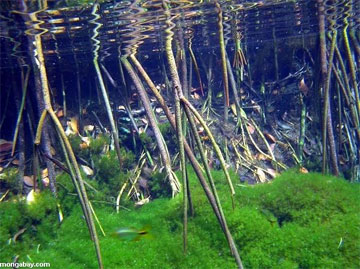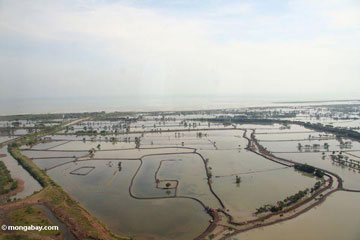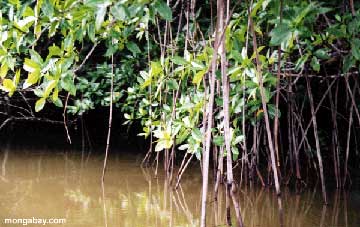Mangroves more threatened than rainforests
Mangroves more threatened than rainforests
Rhett A. Butler, mongabay.com
July 5, 2007
Destruction of mangrove forests could leave the world deprived of their important ecological services by the end of a century, warns an international team of scientists writing in the July 6th issue of the journal Science.
Mangrove forests, which once covered more than 200,000 square kilometers of coastline, have been diminished by 35-86 percent in extent in locations around the world, according to the U.N. Food and Agriculture Organization, and are critically endangered or approaching extinction in 26 out of the 120 countries in which they are found. Further, mangrove forests are disappearing at a rate of 1-2 percent per year, a pace that surpasses the destruction of adjacent ecosystems, coral reefs and tropical rainforests. These losses, combined with increasing fragmentation of mangroves, reduces their viability and the quality of the services–including controlling coastal erosion, buffering against storm damage, and serving as a refuge for wildlife–they provide.
 Underwater photo of mangrove roots in the Yucatan, Mexico. Photo by R. Butler. The U.N. estimates that 20 percent of the planet’s mangroves were lost between 1980 and 2005. Mangroves are most threatened by harvesting for timber and charcoal, freshwater diversion, real estate development, conversion for tourism and shrimp farms, and clearing for agriculture (notably oil palm plantations and rice) |
“Where mangrove forests are cleared for aquaculture, urbanization, or coastal landfill or deteriorate due to indirect effects of pollution and upstream land use, their species richness is expected to decline precipitously,” write the authors. “Examples from other ecosystems have shown that species extinctions can be followed by loss in functional diversity, particularly in species-poor systems like mangroves… Therefore, any further decline in mangrove area is likely to be followed by accelerated functional losses.”
The scientists warn that deforestation of mangroves “reduces their dual capacity to be both an atmospheric CO2 sink and an essential source of oceanic carbon,” while damaging fisheries, worsening siltation, and adversely affecting coastal communities by putting them at greater risk of flooding from storm surges, sea level rise, and tsunami.
|
|
Despite their importance, the authors say that mangroves are under appreciated and that growing pressure from development, agriculture, and industry will put these forests at ever greater risk. The authors add that climate change and the associated rise in sea level could be particularly detrimental to mangroves and that urgent action is needed to protect them.
“We are greatly concerned that the full implications of mangrove loss for humankind are not fully appreciated,” write the authors, led by Dr. N. C. Duke of the Centre for Marine Studies at the University of Queensland in Australia. “Growing pressures of urban and industrial developments along coastlines, combined with climate change and sea-level rise, urge the need to conserve, protect, and restore tidal wetlands.”
“Effective governance structures, socioeconomic risk policies, and education strategies are needed now to enable societies around the world to reverse the trend of mangrove loss and ensure that future generations enjoy the ecosystem services provided by such valuable natural ecosystems,” they conclude.
Mangrove forest is found in silt-rich, saline habitats worldwide, generally along large river deltas, estuaries, and coastal areas. It is characterized by low tree diversity, almost exclusively mangroves, with a low broken canopy. Mangroves are evergreen trees and shrubs that are well adapted to their salty and swampy habitat by having breathing roots (pneumatophores) that emerge from the oxygen-deficient mud to absorb oxygen.
Related articles
Panama Canal port projects threaten mangroves
Port development and land speculation in Panama is turning some of the Caribbean’s most productive mangrove forests into landfill. The landfill would be used for container storage near the city of Colon, at the mouth of the Panama Canal. But local scientists say the transformation could have unintended environmental consequences.
70% of Indonesia’s mangrove forests damaged
70 percent of Indonesia’s remaining mangrove forests are damaged due to human activities, Indonesian state media reported a local expert as saying. Dr. Cecep Kusmana, a professor at the Bogor Institute of Technology, told ANTARA News that forestry ministry data shows about 6.7 million of Indonesia’s 9.4 million hectares of mangrove forest are damaged, including 2.2 million of which are “seriously degraded.” The figures do not include mangrove forest that has been cleared or converted for agriculture.
Coral reefs and mangroves have high economic value
Protecting coral reefs and mangrove forests makes economic sense according to a new report by the United Nations Environment Programme (UNEP). The report, titled “In the Front Line: Shoreline Protection and other Ecosystem Services from Mangroves and Coral Reefs”, argues that conserving these ecosystems for the services they provide—from fisheries protection to erosion control to a source for medical compounds—is cost-effective relative to destroying them and substituting their role with man-made structures.
CITATION: Duke N.C. et al, “A World Without Mangroves?”; published in Science, 6 July 2007

